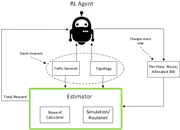2023
Project Title:
GNN Based DRL for 6G Cellular Access Network Schedular
Supervisors:
Barak Gahtan, Eran Tavor
Description:
As the demand for mobile high bandwidth – low latency is increasing, the access network must become smarter and automatically adapt to rapid changes. A scheduler is a module that observes the network, receive traffic requests from all users and allocates a bandwidth and a specific route to each requested connection. In order to accomplish the scheduling task quickly and efficiently, you will further develop a Deep Reinforcement Learning (DRL) based scheduler that observes the network (the environment), receives traffic requests and allocates route and bandwidth to each traffic request. The focus of this semester’s project is to replace the neural network of the DRL algorithm with a graph neural network (GNN) type of “brain”. The GNN will be tailored for a dynamic topology.

Project Title:
AI-Based Firewall - Nvidia
Supervisors:
Idan Barnea- NVIDIA, Eran Tavor - Technion
Description:
The goal of this project is to develop a live AI-based firewall. In this project you will deploy the P4Runtime software package on a high-performance switch (25+ Gigabits per second) and use AI to create a live firewall. The system that you will build will do the following: 1. Extract data at a high rate from the switch and deliver it to an AI engine 2. Classify the data with an AI algorithm 3. Act according to the AI classification: add/delete entries to the tables in the switch. This part will use the new P4Runtime engine 4. Drop/pass packets according to the classification. This is the goal of the firewall The project’s outcome will probably be one of the first AI-based firewalls that run in real-time.

Project Title:
RL Based 6G Cellular Access Network Schedular
Supervisors:
Eran Tavor
Description:
As the demand for mobile high bandwidth – low latency is increasing, the access network must become smarter and automatically adapt to rapid changes. A scheduler is a module that observes the network, receives traffic requests from all users and allocates bandwidth and a specific route to each requested connection. In order to accomplish the scheduling task quickly and efficiently, you will develop a Reinforcement Learning based scheduler that observes the network (the environment), receives traffic requests and allocates route and bandwidth to each traffic request.
The main focus of this semester's project is to develop an OMNET++ simulator that will be used as the digital twin of the real-world 6G access network and replace the Routenet model that was used in last semester project

Project Title:
Multi-flow QUIC Evaluation
Supervisors:
Eran Tavor
Description:
QUIC is a secure general-purpose, highly encrypted, multiplexed, and low-latency transport protocol designed from the ground up to improve transport performance for HTTPS traffic. QUIC has recently (May 2021) became RFC standard (RFC 9000) and is expected to become the dominant transport protocol in the Internet over TCP. Multipath QUIC is an extension to the QUIC protocol that enables hosts to exchange data over multiple networks over a single connection. Compared to Multipath QUIC, Multi-flow QUIC gets rid of the bidirectional constraint to fully take advantage of asymmetric, or even unidirectional, network paths. In this project you will explore these two variants and compare their performance to TCP.

Project Title:
Encrypted Traffic Classification - ML based tool
Supervisors:
Eran Tavor
Description:
Traffic classification, the categorization of network traffic into appropriate classes, is important to many applications, such as quality of experience (QoE) control, pricing, resource usage planning, malware detection, and intrusion detection. While encrypted TCP traffic exposes a lot of information in the TCP header, QUIC traffic is almost fully encrypted leaving only a few features to hold on for classifying the traffic data.
Most (if not all) of the giant internet companies use QUIC for transport data. This project aims to develop a traffic classification tool that identifies the application that generated the encrypted (QUIC) traffic.

Project Title:
Ethereum Block Chain Mempool Analysis
Supervisors:
Avi Mizrahi, Eran Tavor
Description:
The popularity of cryptocurrencies, such as Bitcoin and Ethereum, attracts attention to their underlying technology, the Blockchain. A Blockchain is a databases based on chain of blocks, and each block is composed of set of transactions. To form a new block at the top of the chain, nodes in the system share new transactions between them, until one of them can pack a set into new block. For that, nodes in the network maintain a local pool of pending transactions, usually called mempool. Mempool synchronization takes major part of the network bandwidth, hence it is valuable to find an efficient algorithm for it.

Project Title:
Raspberry PI based Router
Supervisors:
Eran Tavor
Description:
Routers are traditionally very expensive and complicated devices. In this project you will develop a modern layer 3 router using a novel Switch programmable language (P4). The hardware of the router is based on RaspberryPi 4 Single Board Computer (SBC) and the software is based on the P4 open source compiler T4PAS.
The Router’s design is separated to a Data Plane – programmed in P4 and a Control Plane – programmed in python.



